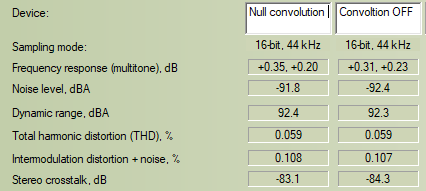I’m hesitant to write the next 2 paragraphs, as I know that the average reader will draw incorrect conclusions from them.
I write it anyway, because I think it’s an interesting observation. Please keep this in mind while reading.
It seems that the bitstream is (indeed) no longer 100% bit perfect, when this NULL filter is applied.
As I have no direct method of checking that, I just tried to feed a DTS stream through it. If it comes out as DTS, then you’re sure that nothing has changed. If it doesn’t, then something MUST have been changed.
Turns out, that the stream is no longer a DTS stream, as soon as I load the NULL filter. Thus, something must have changed.
(The file used, was a DTSwav. Which is a multichannel DTS file, but encapsulated in a 44.1/16 stereo WAV. It should just be passed through as a stereo WAV, and only become multichannel sound once your receiver decodes the stream)
I do not know why. Perhaps there are slight changes / rounding errors in the double bit depth conversion. Although that does not seem logical to me.
Perhaps something else. I’m not that knowledgeble in digital audio. Perhaps this could be a fun question for @Brian ?
Now, what I find more important : does that also reflect in the analog/electrical domain ? In other words : does that change, alter something in the final sound ?
As said, I cannot make proper measurements through Roon; my equipment requires Roon to have a line-in for that.
So I had to make some nastier measurements (which I really don’t like doing…).
Setup involves two soundcards : one very very highend card. And the other is the onboard one of an Intel NUC. Which is pretty bad, and which is the main reason why some of the numbers are not as pretty as they should be.
Instead of giving you 12 graphs, I’ll just give you the most relevant numbers.
I can give you the graphs if you want, but they are só close to each other, that it borders on insanity :

You should know or observe the following with these numbers :
- All deviations you see, are within the error or repeatability. Meaning : measuring the exact same thing twice, can give the same deviaton.
- You spoke about dynamics, and ‘detail and precence’. The latter one is a subjective one (as opposed to a measureble quantity). I would personnally seek this in the frequency spectrum. As you can see : there are virtually no differences, there . The largest one is 0.35-031 = 0.04dB.
- Dynamics : My measurements are flawed here by the NUC. There must certaintly be more dynamic range (and less noise), than 92dB.
In any way : you can hardly observe a difference. More important : 92dB is already way more than the (instanteneous, mind you!) dynamic range of your hearing.
And most certaintainly : way more than is possible, or even desirable, to achieve in a normal living room.
- Dynamics/noise again : I can improve this measurement, by turning up the NUC volume (not good for all other measurements, it’s now pushed too hard),
This way, I could see there is still no difference around -104dB. An insanely low level; I can guarantee you there is no human the world that can hear a signal 104dB lower, than the larger signal.
Wheh, this post grew a lot larger than I thought before starting  .
.
TLDR : Yes, bitstream seems to be changed. I cannot be sure right now, however. It can be a minor change that does not relate to audio reproduction, at all.
But as unlikely as it seems : I cannot deny, that the other extremity is a possibity too.
When checked in the analog/electric domain : no change can be observed. Not even humanly-undetectable small ones.
OH : Would you please let me know, in case this kind of info is not desirable in your topic ? I know how sensitive audio enthousiasts can be, when presented with numbers and theory… Just as as sensitive as ‘objectivists’ are, when presented with opinions and findings  .
.
 , just looking for a solution. Thanks for confirming the WAV is indeed a null file. I have confidence in HAF.
, just looking for a solution. Thanks for confirming the WAV is indeed a null file. I have confidence in HAF. .
. .
.
 .
. .
.